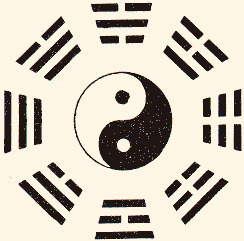
This page is only one of many thousands of Gotheborg.com Help and Information Pages, offering specialized knowledge on Chinese and Japanese Porcelain, including a Glossary, Q&A, Chinese and Japanese Porcelain Marks, Chinese Porcelain Exhibition and Excavation reports etc. For personal help and far more information, join our Discussion Board or use 'Ask a Question' for quick email consultations. For full text and better navigation, use a full-screen device rather than a mobile phone, that offers only limited content.

The Eight Trigrams are represented by eight sets of three straight lines often arranged in a circle. They are said to have been evolved from the markings on the shell of a tortoise by the legendary Emperor Fuxi.
They are built up by unbroken lines representing Yang or "the male principle" and broken lines, representing Ying or "the Female principle". The arrangement in a circle is important as this is referring to the cyclic changes of the nature and is fundamental for the understanding of Chinese philosophy from its earliest beginning.
In the middle of the figure we have the Yin and Yang symbol of creation.
The founder of the Zhou dynasty (11th century (1027) to 221 B.C.)- is said to have been the one who first appended to each of them certain explantions. This work was continued by his son, and this is what is described in the "Book of Changes", the most venerated and least understood of all Chinese classics.
The following table shows the objects each of the eight trigrams represent, their attributes, their appropriate animals and the points of the compass to which they refer.
When properly studied these diagrams will tell you the secrets of divination, geomancy, the elements of metaphysical knowledge and the clue to the secret of creation.

| 
| 
| 
| 
| 
| 
| 
|
| Heaven, the sky | Water collected in a mars or lake | Fire as in lightning, the sun | Thunder | The wind, wood | Water as in rain, clouds, springs, streams, the moon | Hills or mountains | The Earth |
| Untiring strength, power | Pleasure, complacent satisfaction | Brightness, elegance | Moving exciting power | Flexibility, penetration | Peril, difficulty | Resting | Capacious- ness, submission |
| Horse | Goat | Phesant | Dragon | Fowl | Swine | Dog | Ox |
| South | South East | East | North East | South West | West | North West | North |
Interestingly enough this is basically the same system as binary digits (ones and zeroes) arranged in groups of eight times three.
Thank you for your interest.
Best regards,
Jan-Erik Nilsson